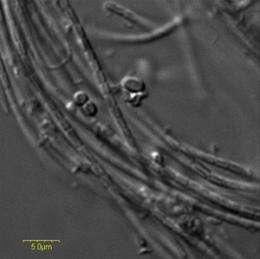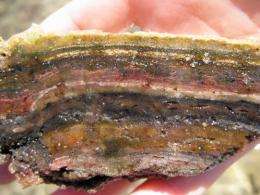Scientists discover first new chlorophyll in 60 years

(PhysOrg.com) -- University of Sydney scientists have stumbled upon the first new chlorophyll to be discovered in over 60 years and have published their findings in the international journal Science.
Found by accident in stromatolites from Western Australia's Shark Bay, the new pigment named chlorophyll f can utilise lower light energy than any other known chlorophyll.
The historic study published online in Science, challenges our understanding of the physical limits of photosynthesis - revealing that small-scale molecular changes to the structure of chlorophyll allows photosynthetic organisms to survive in almost any environment on Earth.
The new chlorophyll was discovered deep within stromatolites - rock-like structures built by photosynthetic bacteria, called cyanobacteria - by lead author Dr Min Chen from the University of Sydney.
A team of interdisciplinary scientists, including Dr Martin Schliep and Dr Zhengli Cai (University of Sydney); Associate Professor Robert Willows (Macquarie University); Professor Brett Neilan (University of New South Wales) and Professor Hugo Scheer (University of Munich), characterised the absorption properties and chemical structure of chlorophyll f, making it the fifth known type of chlorophyll molecule on Earth.
Chlorophyll is the essential molecule in oxygenic photosynthesis - the process that enables plants, algae and some bacteria to convert carbon dioxide into sugar and oxygen by using free energy from sunlight. Until recently, oxygenic photosynthesis was thought only to occur in light that is visible to human eyes, between 400nm to 700nm, as chlorophyll was strictly limited to absorbing light in this range.
This was overturned in 1996 when scientists found a cyanobacterium that could photosynthesise using light just outside the visible spectrum - at 710nm, in the infrared region - using a modified chlorophyll molecule, named chlorophyll d. Since this discovery, scientists around the world have been puzzled by how chlorophyll d is able to get enough energy from infrared light for photosynthesis.
Now the rules of photosynthesis need to be rewritten again, with the discovery of a new chlorophyll that can absorb light of even lower photon energy - 720nm - making it the most red-shifted chlorophyll to date.
In ecological terms, chlorophyll f allows cyanobacteria living deep within stromatolites to photosynthesise using low-energy infrared light, the only light able to penetrate into the structure, which challenges further our understanding of the physical limits of photosynthesis.
Dr Chen, from the School of Biological Sciences, explains: "Finding the new chlorophyll was totally unexpected - it was one of those serendipitous moments of scientific discovery.
"I was actually looking for chlorophyll d, which we knew could be found in cyanobacteria living in low light conditions. I thought that stromatolites would be a good place to look, since the bacteria in the middle of the structures don't get as much light as those on the edge."

After obtaining a sample of stromatolite from Hamelin Pool, Dr Chen looked for chlorophyll d by culturing the cyanobacterial sample in infrared light of 720nm. This ensured only the survival of cyanobacteria that had chlorophylls able to absorb and use infrared light.
High performance liquid chromatography of the cultured sample performed six months later revealed not only trace amounts of chlorophyll d, but also a new chlorophyll not seen before.
Testing the optical absorption spectrum of the new chlorophyll revealed that it could absorb much longer wavelengths of light than any other known chlorophyll - 10nm longer than chlorophyll d and more than 40nm longer than chlorophyll a.
Sequential mass spectral analysis revealed the molecular weight of the new pigment to be 906 mass units. Then nuclear magnetic resonance (NMR) spectroscopy was performed to determine the chemical structure of the chlorophyll. Results indicated that chlorophylls a, b, d and f have very similar chemical structures, differing only in the position of a substitution. Yet these tiny differences in structure give the chlorophylls very different spectral properties, and hence can function in very different light environments.
"Discovering this new chlorophyll has completely overturned the traditional notion that photosynthesis needs high energy light," Dr Chen said.
"It is amazing that this new molecule, with a simple change to its chemical structure, can absorb extremely low energy light. This means that photosynthetic organisms can utilise a much larger portion of the solar spectrum than we previously thought and that the efficiency of photosynthesis is much greater than we ever imagined.
"Chlorophyll f, and its ability to absorb infrared light, can have numerous applications to industries like plant biotechnology and bioenergy.
"For us, the next challenge is to work out the function of this new chlorophyll in photosynthesis.
"Is its job to capture additional red light and pass it on to another chlorophyll, like chlorophyll a, in the reaction centre for photosynthesis?
"Or is it the only chlorophyll responsible for photosynthesis in the cyanobacterium? And if it is, then we will be speechless wondering how this molecule can get enough energy from infrared light to make oxygen from water.
"Whatever happens next, the fact that we have discovered a cyanobacterium that exploits a tiny modification in its chlorophyll molecule to photosynthesise in light that we cannot see, opens our mind to the seemingly limitless ways that organisms adapt to survive in their environment."
More information: www.sciencemag.org/cgi/content … ract/science.1191127
Provided by University of Sydney
















